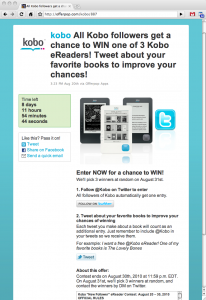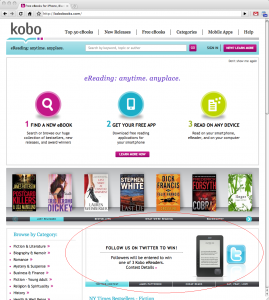Email Plus Facebook Marketing: Fresh ideas from FreshPair
 There is a certain tribe of marketers out there that are Pied Pipers for a new way of thinking. Email is dead. Get social.
There is a certain tribe of marketers out there that are Pied Pipers for a new way of thinking. Email is dead. Get social.
Well, there are many metrics I can give to refute that stance, but here’s my favorite – paid attendance to next week’s MarketingSherpa Email Summit 2011 is up 40% from last year.
Horn tooting done, my point is that the best strategy for most marketers is to engage in both email AND social media marketing, despite what the rhetoric-filled and biased bloggers out there may say. This may not be shocking news to you. Your bigger question is likely – but how?
Well, that’s why we have the Email Summit to begin with, to learn from all the high-performing marketers out there. So, I turned to Lindsay Massey, Marketing Director, Freshpair to share some techniques and tactics that might help your efforts.
Lindsay is a panelist for the how-to panel at Email Summit entitled, “Growing Email Lists and Engaging Customers with Social Media.” Freshpair.com is a leading intimate apparel retailer. You can find them on Facebook and follow them on Twitter. But first, read on…
So, the first thing that jumps out at me from your successful campaign is that Facebook is the “next big thing” in email, while email is supposedly “dead.” Yet, essentially, to me your campaign was really just a traditional email send where Facebook was the conversion goal. “Dead” delivers I guess? How did you approach this send similar to other promotional sends, and in what ways was it different?
Lindsay Massey: We look at email and social as great complements to each other, and we definitely don’t see email as “dead.” After all, how does Facebook notify you that you have new comments or messages? Email!
By engaging our email subscribers in another relevant channel, we are able to interact with them on a more personal level, share unique content to generate buzz and ultimately engage more people in our brand. We approached this send like other promotional sends that are part of a larger campaign in that we developed an offer, segmented our list to target customers with the highest propensity to participate and, where this message would be relevant, created supporting content on Facebook and tracked the results.
This email campaign was different from other promotional sends in that the main goal was to encourage people to follow us on Facebook rather than go straight to freshpair.com. We measured the success differently than other campaigns – number of fans in addition to standard email KPIs.
Why email? Why not, say, Twitter?
LM: We definitely promote our Facebook presence on Twitter as well. The email was just one piece of our overall campaign. We chose to promote Facebook over Twitter for this particular campaign, mainly because Facebook allows you to customize the experience more than Twitter.
We were able to show more content tying back to the email. As soon as a customer fanned us, we were able to display new content that gave them the offer and let them click to freshpair.com to shop. A different approach could definitely be utilized on Twitter and would be a great follow-up campaign.
What is the importance of a Facebook fan-acquisition campaign? What is the value of a Facebook fan?
LM: For us, the goal of a Facebook presence is to strengthen our brand and reach new customers. By encouraging our existing customers and brand loyalists to join, we are able to build our relationship with them, as well as encourage them to share us with their friends.
Buying intimate apparel online can be challenging, so we try to educate fans with photos and take on a friendly tone by sharing funny statistics, like what percentage of people own a lucky pair of underwear. By keeping followers engaged and giving them unique content, we leave a favorable impression, so they remember us when it’s time for a fresh pair!
When it comes to measuring social media, the focus must go beyond traditional e-commerce analytics. We use Omniture to gauge the impact of our Facebook presence, specifically the conversion rates of visitors coming from Facebook. However, we consider Facebook to be more of a branding tool, so the exact value of a Facebook fan goes beyond the data in Omniture.
We also look at fan count and interactions. The customer insight you gather through social media will help you develop strategies across all marketing channels to get new customers in the door and keep them in the door. For example, we test different types of content within posts to see what people are most interested in interacting with. We then use this to inform marketing campaigns to further shape our other social initiatives.
Why aren’t social media sharing buttons enough?
LM: The social media sharing buttons are also important, and we include those in our campaigns as well. However, we see the main content receive the majority of clicks, while the share buttons receive a very small fraction of the clicks in each email campaign. We felt it was important to dedicate an entire campaign to acquire fans, but we also continue to push social through emails and onsite messaging as well.
It’s important to note that one dedicated email is not enough. Acquiring Facebook fans or Twitter followers should be an ongoing effort across channels in order to see the best results. Social isn’t just about sharing content, it’s also about extending interaction to new spheres and providing additional value to your fans. Share buttons are limited in that they don’t allow you to proactively communicate with interested parties and build your brand.
What is the downside of a dedicated send to try to attract Facebook fans?
LM: We didn’t see a downside to this specific campaign. The unsubscribe rate was not higher than a regular promotional send, and the segment of customers we mailed was highly engaged. The subject line actually led to an open rate that was 40% higher than average.
For all the marketing VPs and directors out there, what are the biggest lessons they should take away from your success?
LM: Email can be a very effective driver for Social. Before you begin a Facebook acquisition campaign, be sure you have a clear goal and strategy in place, as well as a supporting content strategy for your Facebook page.
Also, you could start small with a test to your most engaged customers to gauge response before you roll it out to a larger list. Then continue to marry your email and social strategies, so customers can get the information they want in the form they like best.
One of the things that we struggle with is catering to multiple demographics – some people want to see pictures of men in underwear and some people want advice on which bras go with what. Before you push your social presence to your entire list, make sure that you have a defined content strategy (either focus on one demo or have something for everyone so no one feels left out).
As for Facebook specifically:
- Be sure to develop a clear strategy for Facebook overall, so new and existing fans continue to be engaged. If you are just on Facebook to be on Facebook or because your competitors are there, take a step back and rethink your long-term strategy.
- Be sure to devote resources once your strategy is in place, so your Facebook page stays current. Take time to engage with your fans and continue to provide them with unique and interesting content.
- Promote your acquisition campaign across multiple marketing channels – not just email, and be sure to track your results.
Related Resources
Email Marketing: Finding the time to improve results
MarketingSherpa Email Summit 2011
MarketingSherpa Email Essentials Workshop Training
Email Marketing: A customer-focused mindset at ATP World Tour
Photo by: Adihrespati












